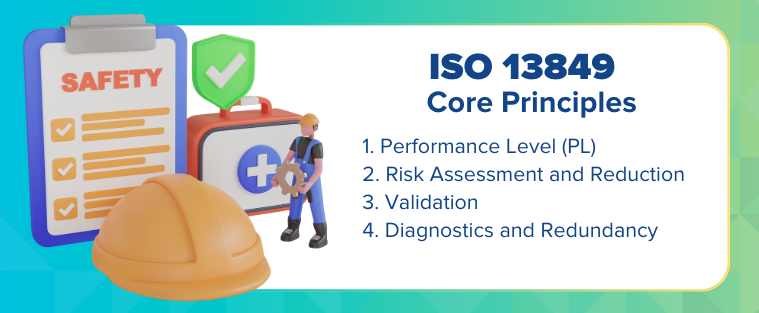Understanding ISO 13849: The Foundation of Functional Safety in the Machinery Sector
Like many industries, functional safety is a critical part of machinery design – ensuring the protection of operators, equipment (and surrounding environments) from hazardous situations. To help maintain functional safety in industrial manufacturing, most organizations use ISO 13849, a globally recognized standard that provides comprehensive guidelines for achieving and validating functional safety in machinery control systems. In this blog, we’ll look at the importance of ISO 13849, key components, and how it shapes functional safety in the machinery sector.
According to an informal ISO/TC stakeholder survey, more than 89% of machine builders and more than 90% of component manufacturers and service providers use ISO 13849 as their functional safety standard.
What is ISO 13849?
Officially titled “Safety of machinery – Safety-related parts of control systems”, ISO 13849 is an official standard that outlines the principles for designing and assessing the safety-related parts of control systems (SRP/CS). These are systems that directly influence the safety functions of a machine, e.g., emergency stops, interlocks, and protective barriers.
- ISO 13849-1: Focuses on general principles for design and performance.
- ISO 13849-2: Covers validation procedures for ensuring the compliance of safety functions.
By following this standard, manufacturers can reduce the likelihood of machinery-related accidents and improve overall safety compliance.
RELATED: IEC 61508 Overview: The Complete Guide for Functional Safety in Industrial Manufacturing
Why is ISO 13849 Essential in the Machinery Industry?
Is it mandatory? Well, no.
However, the machinery sector operates in environments where equipment malfunctions can lead to severe injuries, fatalities, and property damage. Functional safety – as defined by ISO 13849 – helps mitigate these risks by emphasizing:
- Reducing Risk: Identifying potential hazards and designing systems to minimize them.
- Reliability: Ensuring that safety-related control systems perform their intended functions under all expected conditions.
It’s also important to note that compliance with this standard can also help teams avoid legal and financial repercussions if something does go wrong.
ISO 13849 bridges the gap between innovation and safety, enabling manufacturers to integrate cutting-edge technology without compromising operator protection.
Key Info about ISO 13849
ISO 13849 revolves around several core principles:
1: Performance Level (PL) – Performance Level quantifies the reliability of safety functions, categorized from PL a (lowest) to PL e (highest). Factors influencing PL include:
- Hardware structure.
- Diagnostic coverage (DC).
- Mean time to dangerous failure (MTTFd).
- Common cause failure (CCF) protection.
2. Risk Assessment and Reduction – Part of this standard is the emphasis on conducting thorough risk assessments to identify potential hazards and determine the necessary PL for mitigation.
3. Validation – Validation ensures that the implemented safety functions meet design specs and operate correctly under foreseeable conditions. ISO 13849-2 provides specific procedures for this step.
4. Diagnostics and Redundancy – Built-in diagnostics and redundant systems enhance reliability, preventing failures from leading to unsafe conditions.
Implementing in Functional Safety Design
Successfully implementing ISO 13849 needs a structured approach:
- Risk Assessment: Analyze the machinery’s operational scenarios to identify risks.
- Determine Safety Requirements: Define safety functions and their corresponding Performance Levels.
- Design Safety Systems: Develop control systems with redundancy, diagnostic coverage, and robust design principles.
- Validation: Test and validate by comparing to ISO 13849-2 to make sure you’re compliant.
Benefits of Choosing to Comply
Adhering to ISO 13849 delivers a lot of advantages for machinery manufacturers and operators:
- Enhanced Safety: Reduces the risk of accidents and improves operator confidence.
- Regulatory Compliance: You’ll meet international safety standards, facilitating market entry and reducing liability.
- Cost Efficiency: Minimizes downtime and damage from malfunctions.
- Reputation Management: Demonstrates a commitment to safety and reliability, boosting brand credibility.
RELATED: Traceable Agile™ – Speed AND Quality Are Possible for Software Factories in Safety-critical Industries
Challenges and Best Practices
Implementing ISO 13849 can be challenging, especially for manufacturers unfamiliar with its requirements. Some common obstacles could be:
- Complexity in Risk Assessment: Accurately determining Performance Levels requires expertise.
- Integration with Legacy Systems: Retrofitting older machines can be resource intensive.
- Validation Procedures: Comprehensive testing can be time-consuming.
Some thoughts on overcoming these challenges:
- Engage Experts: Don’t go it alone – collaborate with functional safety specialists.
- Use Certified Components: Choose components that meet ISO 13849 requirements.
- Invest in Training: Help your team succeed! Equip them with the knowledge to apply the standard effectively.
ISO 13849 serves as a cornerstone of functional safety in the machinery sector. By following its guidelines, manufacturers can design systems that not only meet regulatory standards but also provide robust protection against operational risks. In an industry where safety is paramount, ISO 13849 ensures that innovation and reliability go hand in hand.
Note: This article was drafted with the aid of AI. Additional content, edits for accuracy, and industry expertise by Steven Meadow and McKenzie Jonsson.
- Understanding ISO 13849: The Foundation of Functional Safety in the Machinery Sector - February 11, 2025
- [Webinar Recap] Achieving Success in Energy Storage Development: Tips & Best Practices - September 10, 2024
- [Webinar Recap] Managing Functional Safety in Development Efforts for Robotics Development - August 6, 2024

